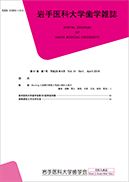Volume 10, Issue 3
Displaying 1-30 of 30 articles from this issue
- |<
- <
- 1
- >
- >|
Originals
-
1985Volume 10Issue 3 Pages 127-135
Published: December 15, 1985
Released on J-STAGE: November 17, 2017
Download PDF (630K) -
1985Volume 10Issue 3 Pages 136-141
Published: December 15, 1985
Released on J-STAGE: November 17, 2017
Download PDF (340K) -
1985Volume 10Issue 3 Pages 142-148
Published: December 15, 1985
Released on J-STAGE: November 17, 2017
Download PDF (2473K) -
1985Volume 10Issue 3 Pages 149-160
Published: December 15, 1985
Released on J-STAGE: November 17, 2017
Download PDF (621K) -
1985Volume 10Issue 3 Pages 161-171
Published: December 15, 1985
Released on J-STAGE: November 17, 2017
Download PDF (3896K) -
1985Volume 10Issue 3 Pages 172-176
Published: December 15, 1985
Released on J-STAGE: November 17, 2017
Download PDF (299K) -
1985Volume 10Issue 3 Pages 177-187
Published: December 15, 1985
Released on J-STAGE: November 17, 2017
Download PDF (532K) -
1985Volume 10Issue 3 Pages 188-194
Published: December 15, 1985
Released on J-STAGE: November 17, 2017
Download PDF (466K) -
1985Volume 10Issue 3 Pages 195-201
Published: December 15, 1985
Released on J-STAGE: November 17, 2017
Download PDF (487K)
Case-report
-
1985Volume 10Issue 3 Pages 202-210
Published: December 15, 1985
Released on J-STAGE: November 17, 2017
Download PDF (946K) -
1985Volume 10Issue 3 Pages 211-216
Published: December 15, 1985
Released on J-STAGE: November 17, 2017
Download PDF (1963K) -
1985Volume 10Issue 3 Pages 217-223
Published: December 15, 1985
Released on J-STAGE: November 17, 2017
Download PDF (1494K)
Symposium
-
1985Volume 10Issue 3 Pages 224-226
Published: December 15, 1985
Released on J-STAGE: November 17, 2017
Download PDF (356K) -
1985Volume 10Issue 3 Pages 226-227
Published: December 15, 1985
Released on J-STAGE: November 17, 2017
Download PDF (152K) -
1985Volume 10Issue 3 Pages 227-229
Published: December 15, 1985
Released on J-STAGE: November 17, 2017
Download PDF (523K) -
1985Volume 10Issue 3 Pages 229-230
Published: December 15, 1985
Released on J-STAGE: November 17, 2017
Download PDF (382K)
-
1985Volume 10Issue 3 Pages 231
Published: December 15, 1985
Released on J-STAGE: November 17, 2017
Download PDF (82K) -
1985Volume 10Issue 3 Pages 231-232
Published: December 15, 1985
Released on J-STAGE: November 17, 2017
Download PDF (164K) -
1985Volume 10Issue 3 Pages 232-233
Published: December 15, 1985
Released on J-STAGE: November 17, 2017
Download PDF (174K) -
1985Volume 10Issue 3 Pages 233
Published: December 15, 1985
Released on J-STAGE: November 17, 2017
Download PDF (92K) -
1985Volume 10Issue 3 Pages 233-234
Published: December 15, 1985
Released on J-STAGE: November 17, 2017
Download PDF (174K) -
1985Volume 10Issue 3 Pages 234-235
Published: December 15, 1985
Released on J-STAGE: November 17, 2017
Download PDF (178K) -
1985Volume 10Issue 3 Pages 235-236
Published: December 15, 1985
Released on J-STAGE: November 17, 2017
Download PDF (178K) -
1985Volume 10Issue 3 Pages 236
Published: December 15, 1985
Released on J-STAGE: November 17, 2017
Download PDF (90K) -
1985Volume 10Issue 3 Pages 236-237
Published: December 15, 1985
Released on J-STAGE: November 17, 2017
Download PDF (172K) -
1985Volume 10Issue 3 Pages 237
Published: December 15, 1985
Released on J-STAGE: November 17, 2017
Download PDF (90K) -
1985Volume 10Issue 3 Pages 237-238
Published: December 15, 1985
Released on J-STAGE: November 17, 2017
Download PDF (134K) -
1985Volume 10Issue 3 Pages 238
Published: December 15, 1985
Released on J-STAGE: November 17, 2017
Download PDF (50K)
Index Vol.10
-
1985Volume 10Issue 3 Pages Toc1-Toc4
Published: December 15, 1985
Released on J-STAGE: November 17, 2017
Download PDF (137K)
Author name Index
-
1985Volume 10Issue 3 Pages Index1-Index2
Published: December 15, 1985
Released on J-STAGE: November 17, 2017
Download PDF (73K)
- |<
- <
- 1
- >
- >|
